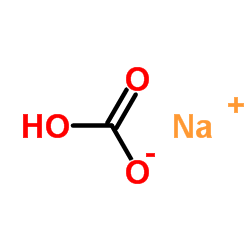碳酸氢钠

碳酸氢钠结构式

|
常用名 | 碳酸氢钠 | 英文名 | SodiuM bicarbonate |
|---|---|---|---|---|
| CAS号 | 144-55-8 | 分子量 | 84.007 | |
| 密度 | 2.16 g/mL at 25 °C(lit.) | 沸点 | 851°C | |
| 分子式 | CHNaO3 | 熔点 | 270 ºC | |
| MSDS | 中文版 美版 | 闪点 | 169.8ºC |
|
Pro-apoptotic and pro-autophagic effects of the Aurora kinase A inhibitor alisertib (MLN8237) on human osteosarcoma U-2 OS and MG-63 cells through the activation of mitochondria-mediated pathway and inhibition of p38 MAPK/PI3K/Akt/mTOR signaling pathway.
Drug Des. Devel. Ther. 9 , 1555-84, (2015) Osteosarcoma (OS) is the most common malignant bone tumor occurring mostly in children and adolescents between 10 and 20 years of age with poor response to current therapeutics. Alisertib (ALS, MLN8237) is a selective Aurora kinase A inhibitor that displays a... |
|
|
Calcium entry via connexin hemichannels in lens epithelium.
Exp. Eye Res. 132 , 52-8, (2015) Exposure to hyposmotic solution causes release of ATP from lens cells via hemichannels. Because hemichannel opening feasibly could swamp the cells with calcium, we carried out studies to measure the magnitude of the increase in cytoplasmic calcium concentrati... |
|
|
H4 histamine receptors inhibit steroidogenesis and proliferation in Leydig cells.
J. Endocrinol. 223(3) , 241-53, (2014) The histamine H4 receptor (HRH4), discovered only 13 years ago, is considered a promising drug target for allergy, inflammation, autoimmune disorders and cancer, as reflected by a steadily growing number of scientific publications and patent applications. Alt... |
|
|
An integrated biological approach to guide the development of metal-chelating inhibitors of influenza virus PA endonuclease.
Mol. Pharmacol. 87(2) , 323-37, (2015) The influenza virus PA endonuclease, which cleaves capped cellular pre-mRNAs to prime viral mRNA synthesis, is a promising target for novel anti-influenza virus therapeutics. The catalytic center of this enzyme resides in the N-terminal part of PA (PA-Nter) a... |
|
|
Transcriptome analysis of Wnt3a-treated triple-negative breast cancer cells.
PLoS ONE 10(4) , e0122333, (2015) The canonical Wnt/β-catenin pathway is activated in triple-negative breast cancer (TNBC). The activation of this pathway leads to the expression of specific target genes depending on the cell/tissue context. Here, we analyzed the transcriptome of two differen... |
|
|
Oncostatin-M differentially regulates mesenchymal and proneural signature genes in gliomas via STAT3 signaling.
Neoplasia 17(2) , 225-37, (2015) Glioblastoma (GBM), the most malignant of the brain tumors is classified on the basis of molecular signature genes using TCGA data into four subtypes- classical, mesenchymal, proneural and neural. The mesenchymal phenotype is associated with greater aggressiv... |
|
|
Proteomic and metabolomic analysis of the carotenogenic yeast Xanthophyllomyces dendrorhous using different carbon sources.
BMC Genomics 16 , 289, (2015) Astaxanthin is a potent antioxidant with increasing biotechnological interest. In Xanthophyllomyces dendrorhous, a natural source of this pigment, carotenogenesis is a complex process regulated through several mechanisms, including the carbon source. X. dendr... |
|
|
Construction and physiochemical characterisation of a multi-composite, potential oral vaccine delivery system (VDS).
Int. J. Pharm. 468(1-2) , 264-71, (2014) An increasing human population requires a secure food supply and a cost effective, oral vaccine delivery system for livestock would help facilitate this end. Recombinant antigen adsorbed onto silica beads and coated with myristic acid, was released (∼15% (w/v... |
|
|
Verification of a canine PSMA (FolH1) antibody.
Anticancer Res. 35(1) , 145-8, (2014) Canine prostate cancer (PC) is a highly aggressive malignancy. However, in contrast to man, neither standard screening strategies nor curative therapeutic options exist for the companion animal. A prostate-specific membrane antigen (PSMA) screening as molecul... |
|
|
Differential effects of light and feeding on circadian organization of peripheral clocks in a forebrain Bmal1 mutant.
Elife 3 , (2015) In order to assess the contribution of a central clock in the hypothalamic suprachiasmatic nucleus (SCN) to circadian behavior and the organization of peripheral clocks, we generated forebrain/SCN-specific Bmal1 knockout mice by using floxed Bmal1 and pan-neu... |